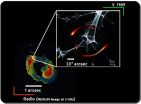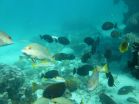(Press-News.org) MANHATTAN -- A new study involving a Kansas State University entomologist reveals that the genes of a fruit fly that has plagued American apple producers for more than 150 years is the result of an extremely rapid evolutionary change.
Greg Ragland, assistant professor of entomology, is co-lead author on a study involving biologists at Rice University, the University of Notre Dame and several other universities. The study looked at the processes that cause a new species to emerge, which may threaten existing, economically important crops. Scientists think that strong environmental changes, such as a drastic change in seasonal weather, can rapidly "push" different sections of an organism's genome -- its genetic blueprint -- into changing.
For the study, researchers focused on the U.S. fruit fly species Rhagoletis pomonella, or the apple maggot fly. Traditionally, the fly lays its eggs in the fruit of the Hawthorn tree, which is native to North America but not considered economically important because of the fruit's overripe taste. In the 1850s, a small group of these flies began laying their eggs in apples.
"At some point the flies jumped to apples, with the adult flies evolving the ability to lay eggs in the fruit and the maggots the ability to consume the fruit," Ragland said. "To do that, regions of the genome had to change from one generation to the next. The result of these flies infesting apples is now a huge issue for the apple production industry because it has introduced a new agricultural pest through an evolutionary event."
Apples mature earlier in the year than Hawthorn fruit. Because of this different maturation window, the group of flies had to begin their lifecycles earlier to match the growth cycle of apples, their new host fruit.
According to Ragland, these seasonal differences essentially equate to two different groups, or taxa, of the fly -- one synchronized with Hawthorn fruit similar to its ancestors and one synchronized with apples. As the behavioral and physical differences in the two flies continue to build each generation, scientists think they may be seeing the formation of a new species.
Work starting as far back as the late 1800s began to reveal these observable differences. This new study builds on that work by showing that environmental differences can change many regions of the genome on time scales even shorter than 150 years.
Researchers discovered this process of rapid adaptation through experiments that looked at the evolutionary differences in the genomes of both flies. They collected flies that laid eggs in Hawthorn fruit and raised one group under seasonal conditions typical of either native Hawthorn fruit or apple-infesting populations. Researchers found that they could replicate the shift from Hawthorn fruit to apples first seen in the 1850s even though all of the flies in the experiment initially laid their eggs in Hawthorn fruit.
"The rapid pace of evolution required to produce the apple-infesting group was initially a surprising result," said Scott Egan, assistant professor at Rice University and co-lead author. "Our results are even more surprising, though, showing that just a few generations of natural selection may have generated apple fly populations that physically and genetically resemble the ones that we see today."
Initially, the team sequenced the genomes of both Hawthorn and apple flies. Following the experiment, they sequenced the flies reared under the short-term Hawthorn-like and apple-like conditions. They found pronounced differences between the short-term rearing conditions across the entire genome. When they compared these results, they found that the genetic changes from the short-term experiment lined up almost completely with the genetic changes between the Hawthorn and apple groups.
"This suggests that many regions of the genome may evolve in as little as a few generations," said Jeff Feder, professor at the University of Notre Dame and co-author. "The genome-wide changes we observe are very likely the result of environmental differences that are driving the formation of new species."
In addition to observing the evolutionary "jump" between host fruits by the two flies, the study sheds new light on how seasonality affects evolution. Better understanding these evolutionary shifts may help scientists better predict when these shifts could happen and what new agricultural pests may result.
"One of the big takeaways is that species are not static; they are fluid to the environment they live in," Ragland said. "From an evolutionary perspective, environmental change can lead to very pronounced genomic differences over very short time scales. They can potentially change all kinds of traits."
The study, "Experimental evidence of genome-wide impact of ecological selection during early stages of speciation-with-gene-flow," will appear in an upcoming issue of the scientific journal Ecology Letters.
INFORMATION:
The National Science Foundation, the U.S. Department of Agriculture and the Environmental Change Initiative at Notre Dame funded the study.
Infectious colonies of bacteria called biofilms that develop on chronic wounds and medical devices can cause serious health problems and are tough to treat. But now scientists have found a way to package antimicrobial compounds from peppermint and cinnamon in tiny capsules that can both kill biofilms and actively promote healing. The researchers say the new material, reported in the journal ACS Nano, could be used as a topical antibacterial treatment and disinfectant.
Many bacteria clump together in sticky plaques in a way that makes them difficult to eliminate with ...
The decline of honey bees has been a major concern globally for the past decade. One of the factors that could be contributing to the decline is the use of insecticides -- specifically neonicotinoids -- that persist in rivers and streams. Researchers now report in the ACS journal Environmental Science & Technology Letters that although sunlight plays an important role in degrading pollutants, its effects on neonicotinoids can diminish dramatically even in shallow water.
Neonicotinoids protect crops from pests, such as whiteflies, beetles and termites. They are a popular ...
Today Nicotine & Tobacco Research publishes the third in a series of studies on the cost of smoking in California, one of the first US states to implement a comprehensive tobacco control program. Researchers estimated expenditures for smoking-attributable costs (healthcare, lost productivity from illness, and lost productivity from premature mortality) for the year 2009. The total cost came to $18.1 billion, amounting to $487 per California resident and $4,603 per smoker.
In two previous studies, conducted in 1989 and 1999, the annual financial impact of smoking on California's ...
Some of the world's most popular foods and seasonings can also be the smelliest -- think garlic, onions, certain cheeses and the notoriously stinky Asian durian fruit. No amount of plastic wrap seems to contain their stench, but now scientists have developed a new film that could finally neutralize the odors of even the most pungent fare. They report their progress in the journal ACS Applied Materials & Interfaces.
The fetid smell of some foods makes it difficult to take them anywhere without offending others such as fellow train or bus riders. But tastes are growing ...
A microbiome code breaker. A carbon dioxide (CO2) wrangler. A bug battler. These aren't members of a new group of super heroes, but a sampling of "The Talented 12" young scientists and entrepreneurs that Chemical & Engineering News (C&EN) magazine is highlighting in a special feature in the latest edition. C&EN is the weekly news magazine of the American Chemical Society (ACS), the world's largest scientific society.
"The Talented 12" includes profiles of a dozen of the best and brightest young researchers who are using chemistry to solve global problems. Among other ...
This news release is available in German.
Turbulent processes take place close to supermassive black holes, which lurk in the centres of nearly all galaxies. They swallow up matter flowing in from the outside while at the same time producing so-called gas jets which shoot out into space in two opposite directions. Researchers at the Max Planck Institute for Physics in Munich and the University of Geneva have now succeeded in localizing the origin of the high-energy gamma radiation in such a jet: it apparently originates very close to the black hole. This discovery ...
New findings about the mechanisms involved - or not involved - in the effects of the most common form of bariatric surgery suggest that combining surgery with a specific type of medication could augment the benefits of the procedure. In a report that has been published online in the journal Endocrinology, Massachusetts General Hospital (MGH) investigators report that the effects of Roux-en-Y gastric bypass (RYGB) do not utilize neurologic pathways controlled by the serotonin 2C receptor. Since that receptor is a proven target for the FDA-approved anti-obesity drug lorcaserin, ...
SPOKANE, Wash.--Washington State University researchers have found that people can manage chronic pain and reduce their reliance on opioids through an Internet-based program that teaches non-medical alternatives like increased physical activity, thinking more positively and dealing with emotions.
Marian Wilson, an assistant professor in the College of Nursing, tracked 43 people with chronic non-cancer pain as they went through an eight-week course of online tools to manage psychological, social and health issues associated with chronic pain. Compared to a similar-sized ...
Researchers have developed a way to help ecosystems bounce back after human disturbances such as shipping, oil exploration or fishing, and have applied it to a coral reef fish species.
The method helps conservation managers create a cost-effective plan to bring species back from the brink of extinction in a local area, by building connections with the same species in nearby locations.
"The world is subject to nasty surprises, and this work for the first time shows how to promote faster species recovery following such a surprise," said Professor Quentin Grafton from ...
In the life of almost every household appliance, there comes that moment of out with the old and in with the new.
However, while electrical and electronic equipment have never been more efficient, economical or in demand, consumers' desire to own the best and the latest is contributing to an environmental issue of increasing seriousness and concern.
"E-waste is one of the fastest growing waste streams in developing, emerging and developed regions and it covers all electrical and electronic equipment and parts discarded by consumers," says Dr Sunil Herat, Associate Editor ...


